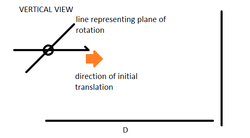Impulses, impulses everywhere...
 Suppose a ball has been thrown at a wall at a speed 'u' from a height 'H' horizontally (parallel to the ground)
Suppose a ball has been thrown at a wall at a speed 'u' from a height 'H' horizontally (parallel to the ground)
It is rotating at an angular velocity of in a plane making 45 degrees with the plane in which it was translating initially.
The wall is at a distance from the launch point,
such that
1)
2)
Let the friction on the floor be sufficiently high to just stop rotation ( See Note )
Find the average force it exerts on the wall when it collides with the wall provided the impact lasts for 2 seconds and it is perfectly elastic
if the answer is 'a'
input the square of a to the closest integer (if it is not an integer)
DETAILS AND ASSUMPTIONS
1) u (initial velocity)=0.7320 approximate as (root(3)-1)
2)w (initial angular velocity)=2.5
4)Mass of Ball=1
5)Radius of ball =1
All in S.I unit
NOTE
1) the inequalities are not the exact necessary conditions example,, if the question requires a<b then i may have altered it as a<b-1 because the second inequality naturally implies the first one,, so as to not reveal the answer,
2) also the figure shows a satelite view of the problem
3) Considering the balls rotation as a vector superposition of angular velocities along different axes might help
This problem was inspired by Let's play cricket
The answer is 3.
This section requires Javascript.
You are seeing this because something didn't load right. We suggest you, (a) try
refreshing the page, (b) enabling javascript if it is disabled on your browser and,
finally, (c)
loading the
non-javascript version of this page
. We're sorry about the hassle.
H I N T : The inequalities simply tell us that the ball bounces just once after the collision,, and before the second time it reaches the ground,, it collides with the wall.
the first inequality tells us that it surely bounces once,, and the second that it only bounces once
After wards apply conservation of angular momentum about the ground,,, using the given fact that it stops rotation after the collision with ground but its essential for angular momentum to remain conserved, which means the resultant translational speed should suffice for whole of rotational motion,
Now that you know angle that the new velocity vector component along ground makes with previous velocity component along ground,,, and also the new velocity component along ground .... use
2 m v c o s ( x ) / t = F a v g .
(since change in momentum is twice initial momentum on collision with wall) which is closest to root 3 whose square is 3.)